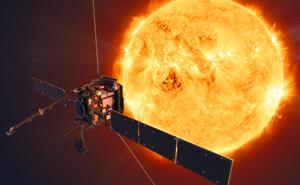The RAL Space team travelled to ESA's Operations Centre in Germany to switch the instrument on and begin to commission the high resolution imaging spectrometer. The Spectral Investigation of the Coronal Environment (SPICE) instrument will observe the Sun at extreme ultraviolet wavelengths.
Tim Grundy, instrument commissioning lead for SPICE said, “We have been waiting with baited breath since the launch to switch our instrument on and check it still works. It was a great relief to get back that first telemetry data and then confirm that the electronics unit is in good working order. This is just the first step in bringing the instrument fully on-line. We also confirmed that the instrument temperatures are close to predictions at this early stage of the mission, and have begun to provide contamination sensor data for the Solar Orbiter team to monitor the spacecraft cleanliness. We are all eager to see the first scientific measurements, and to confirm that SPICE is performing as predicted."
The team were able to check the temperature of the instrument before the switch on at 19.50GMT. Protected by the impressive heatshield, most of the instrument is currently at a 'chilly' minus 11֯C. The detectors are currently being kept warmer at about +18֯C by spacecraft heaters. As Solar Orbiter journeys to the Sun, the spacecraft will have to withstand more than 500֯C. SPICE will be using a novel system to 'dump' extra sunlight, to avoid over-heating while recording spectra at extreme ultraviolet wavelengths.
 The UK-built spacecraft launched from Cape Canaveral on Monday 10th February, beginning its two year journey to the Sun. It will allow scientists to study the Sun and the heliosphere, the giant bubble of plasma surrounding the solar system, in much more detail than previously possible.
The UK-built spacecraft launched from Cape Canaveral on Monday 10th February, beginning its two year journey to the Sun. It will allow scientists to study the Sun and the heliosphere, the giant bubble of plasma surrounding the solar system, in much more detail than previously possible.
The first observations from SPICE, anticipated at the end of 2021, will help us better understand the temperatures, flow velocities and composition of the plasmas in the solar atmosphere. However the instrument will start gathering science data within months. Checks will continue in the coming weeks.
SPICE took 5 years to develop and build by a team of over 80 people from across Europe and the US, led by RAL Space in the UK.
